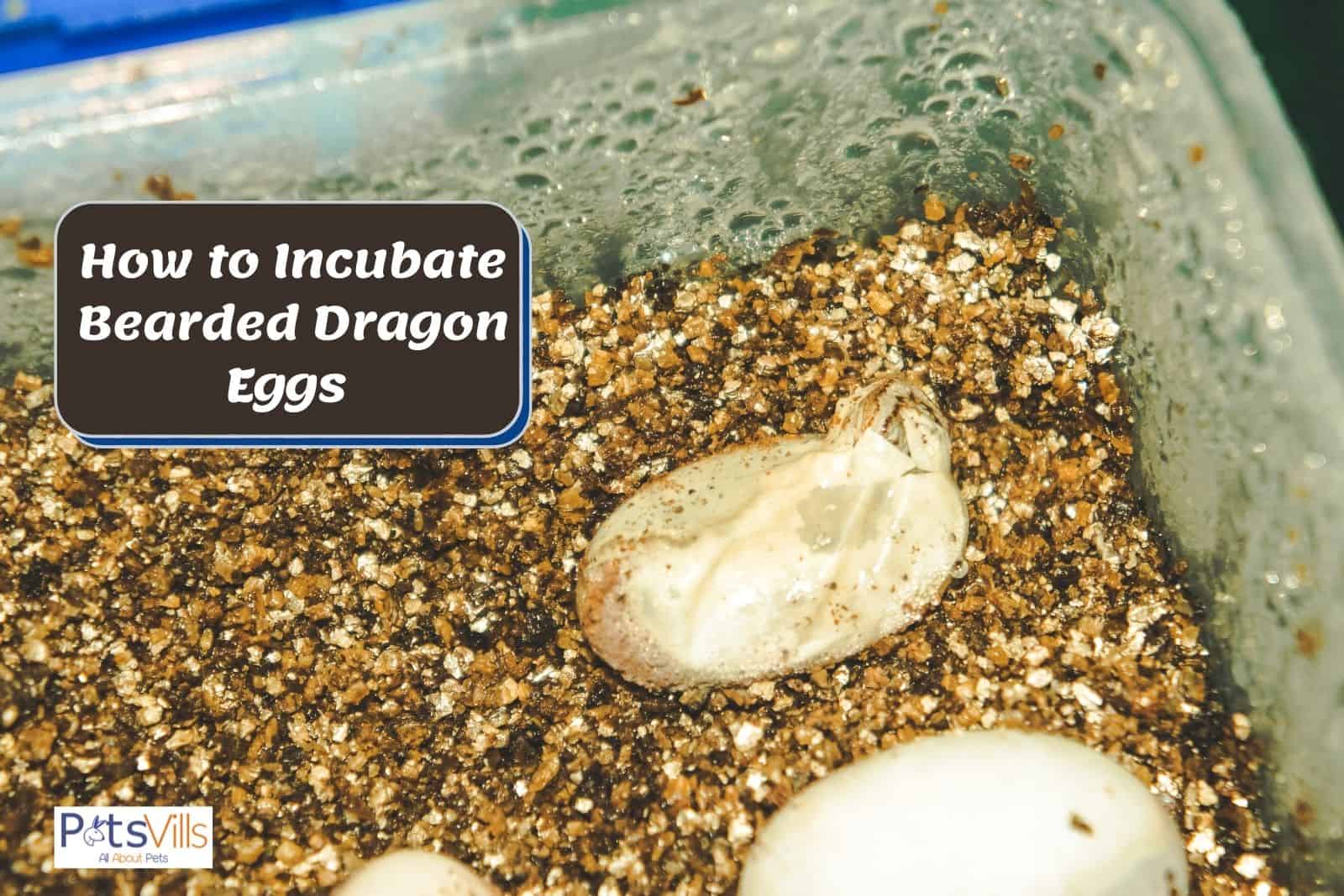Are you wondering how to incubate bearded dragon eggs to hatch them successfully?
While bearded lizards are undemanding pets, caring for a clutch of eggs can be overwhelming for novice reptile owners.
Fortunately, you’ve come to the right place to find step-by-step instructions on how to hatch bearded dragon eggs.
Just keep reading.
Table of Contents
How to Incubate Bearded Dragon Eggs at Home? (11 Steps to Follow)
While bearded lizards are cute and friendly, they don’t make good mothers. Burying the eggs in the soil is pretty much all the maternal behavior a bearded lizard exhibits towards her babies.
So, unless you learn how to take care of bearded dragon eggs, the eggs aren’t going to survive long enough to hatch into baby beardies.
Fortunately, incubating bearded dragon eggs is very easy. You have to place the eggs inside the incubator and set the right humidity and temperature for bearded dragon eggs.
But let’s see the incubation process step-by-step so that you don’t make a mistake.
Step#1 Make a Nest for Your Female Beardie
Adult bearded dragons mate after their brumation period and lay eggs in clutches.
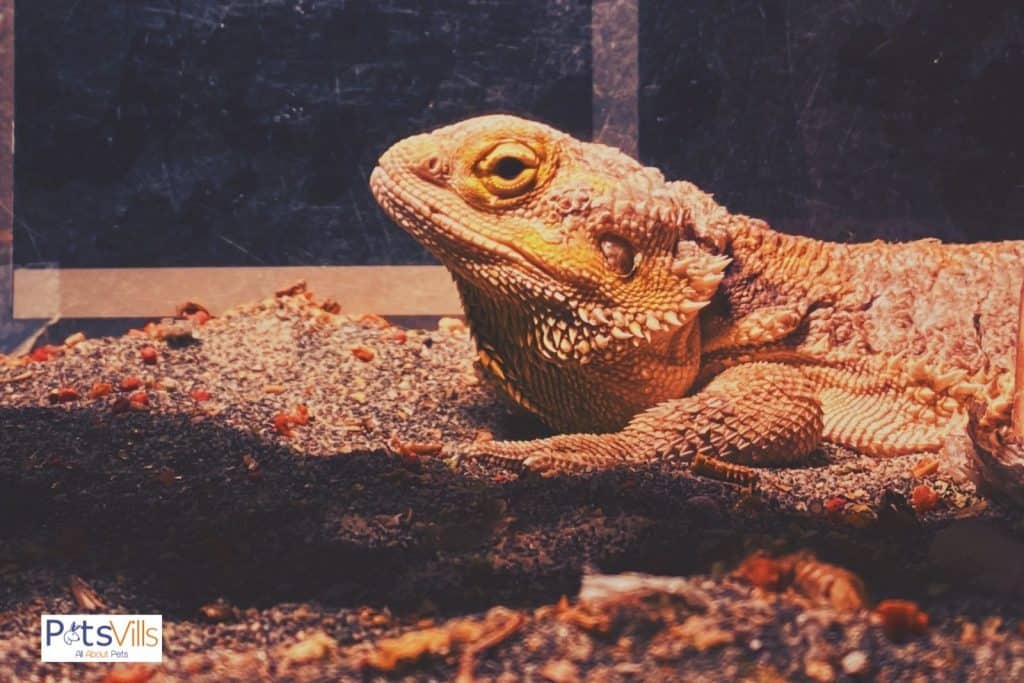
Once your beardie is gravid (pregnant), she will lay her clutch of eggs in about 4-6 weeks. [1] Beforehand, you need to prepare a suitable place for your pregnant beardie to lay her eggs:
- Find a container. It should be big enough for your beardie to turn around and deep enough for her to dig.
- Fill the container with a moist substrate, one suitable for laying eggs.
- Place the container in your bearded lizard’s tank once your gravid female is about to lay the eggs.
Step#2 Pick an Incubator
While you’re waiting for your female dragon to lay her eggs, you should get an incubator. It increases the rate of successful hatchings and is easy to use than a make-shift one.
The best bearded dragon eggs incubator allows you to control the bearded dragon egg incubation humidity and temperature. You’ll learn why these are so important in a bit.
I recommend getting a digital one, which can automatically adjust the humidity and temperature. But any incubator with a built-in thermometer and hygrometer will do.
Step#3 Wait for the Female to Lay Her Eggs
As I already said, bearded lizards lay their eggs four to six weeks after a successful mating. The usual signs are lethargy, often basking under the heat lamp, and excessive digging.
If you have more than one beardie, you should separate them to ensure the female’s comfort during the egg-laying process.
Step#4 Remove the Eggs from the Tank
Usually, bearded lizards dig a hole to bury or half-bury their eggs. If you haven’t provided a container for your lizard to use, the female will deposit the eggs in the soil. You’ll have to dig them and do it quickly.
If your beardie has laid the eggs in the plastic container you’ve provided, just take it out from the enclosure.
Step#5 Check Which Eggs Are Fertile
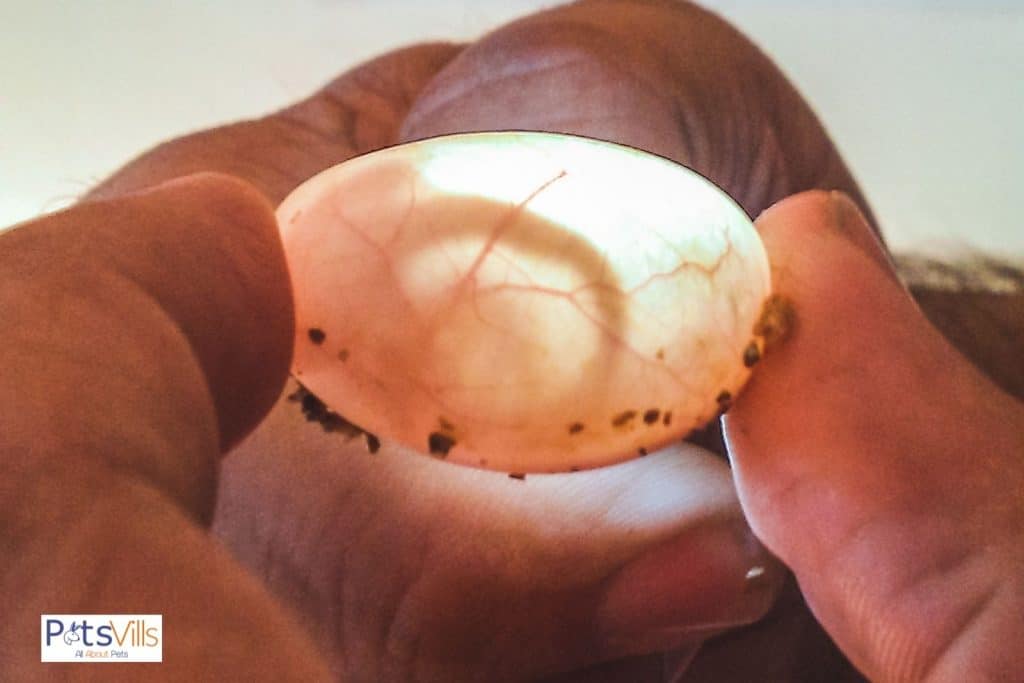
So, what do bearded dragon eggs look like? The eggs are small and oval, usually white or creamy. Yellow eggs or dented ones are likely infertile.
I’ll explain what to do with infertile bearded dragon eggs in a moment.
If you aren’t sure how to tell if the bearded lizard eggs are fertile, you can candle them:
- Pick a bearded dragon egg carefully without rotating it. Too much movement can damage the fragile embryo.
- Put the egg up to bright light, such as a lamp or LED flashlight.
- The egg is fertile if you see any pink/red blood vessels or an embryo shape.
Step#6 Get Rid of Infertile Eggs
There’s no point incubating an infertile clutch of eggs. They won’t hatch and can attract mold and bacteria, which is not good for the rest of the eggs.
You can either throw them out or use them as a fertilizer for the soil. Some owners recommend freezing the eggs before throwing them out.
Step#7 Arrange the Eggs
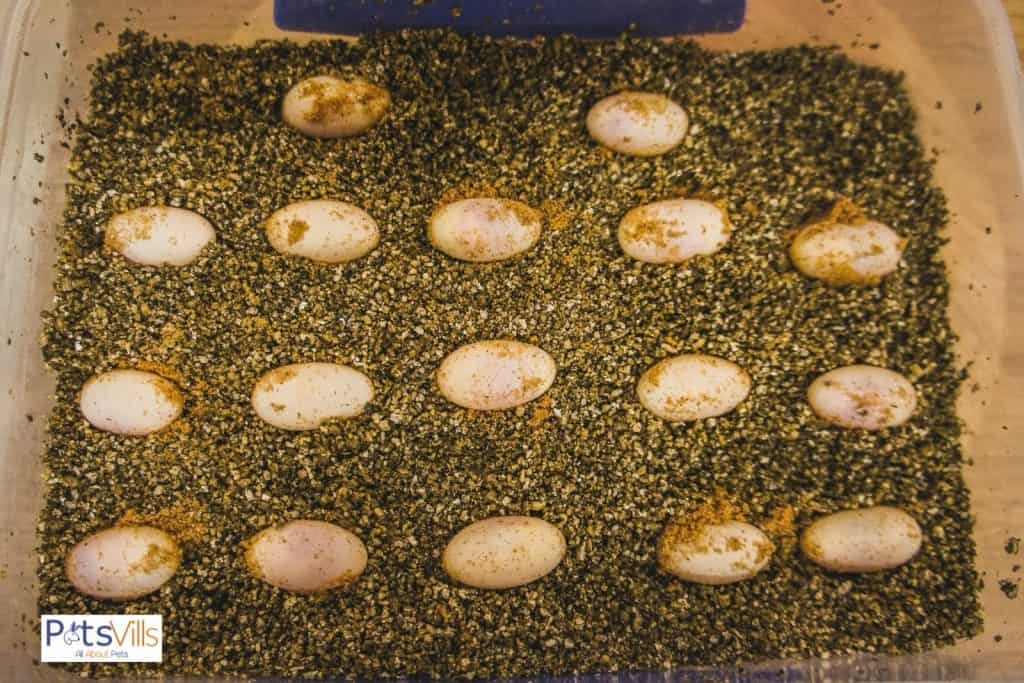
Transfer the eggs to an incubation box filled with a few inches of incubation substrate, such as vermiculite. Choose something transparent so that you can keep an eye on the eggs.
Each egg container should have a tight lid and small ventilation holes.
Make dents or holes in the substrate and arrange the reptile eggs so they can’t roll or move. Leave a couple of inches between each egg because their size will increase during the incubation process.
Depending on how many eggs your beardie lays, you will need several incubation boxes.
Step#8 Move the Eggs to the Incubator
Once you’ve arranged the eggs, you should move them to the incubator. Be very gentle when you’re organizing and moving the eggs.
You mustn’t rotate or turn the eggs. As a study concludes, “eggs should be incubated in the position they were found for optimal results.” [2]
Otherwise, the sudden movement can kill the fragile embryo inside.
Step#9 Set the Bearded Dragon Egg Temperature and Humidity
Once you move the eggs to the incubator, you have to set the temperature and humidity to ensure the bearded dragon eggs continue to thrive.
Some models take up to 12 hours to calibrate and reach the required temperature and humidity. So, you may have to set the incubator the day before the female lays the eggs.
The right temperature for bearded dragon eggs is between 80 to 85 degrees Fahrenheit. The humidity should be at 75%.
Don’t spray the eggs with water to increase the humidity because water promotes mold growth. And check these tips on how to reduce the humidity.
Step#10 Observe and Wait
Depending on the type of incubator, you may have to adjust the bearded dragon egg temperature and humidity level every couple of days.
If you’ve gone for a more sophisticated incubator, all you’ll have to do is keep an eye on the eggs to ensure they’re healthy. Remove any eggs that appear moldy or ooze yellow substance.
Step#11 Repeat with the Next Clutch
Female beardies lay between 1-3 clutches on average per breeding season, and a single clutch has around 20 eggs.
So, you’ll have to repeat the incubation process every couple of months for each clutch your female lays. And your female beardie needs special care between each clutch laying:
- Provide a balanced diet suitable for gravid female reptiles.
- Ask your vet for a calcium supplement to avoid calcium deficiency.
- Check the female to ensure she has laid all the eggs. If there’s a problem, consult with a vet as soon as possible.
If you need more help, here is a great video to watch:
What Temperature Should Bearded Dragon Eggs be Kept at?
The ideal bearded dragon egg incubation temperature is 84 degrees Fahrenheit, but anything within the 80 to 85-degree range is acceptable.
However, temperatures over 85-90 degrees can quickly fry the fragile embryo inside, while temperatures below 80 degrees are far too cold to allow the embryo to develop and grow.
Use a digital thermometer to check you’ve got the right temperature for bearded dragon eggs inside the incubator and adjust accordingly.
Bearded Dragon Incubation Period
You’ve waited more than a month for the baby bearded dragons to hatch. So, how long does a bearded dragon egg take to hatch?
The bearded dragon eggs incubation lasts between 55 and 75 days. However, it can be shorter or longer, depending on many factors, mainly humidity and temperature.
In most cases, after 40-90 days, you should have healthy dragons crawling around the incubation box. The baby dragons will be exhausted for the first few days but should become active after 48 hours.
Signs Bearded Lizard Eggs Are About to Hatch
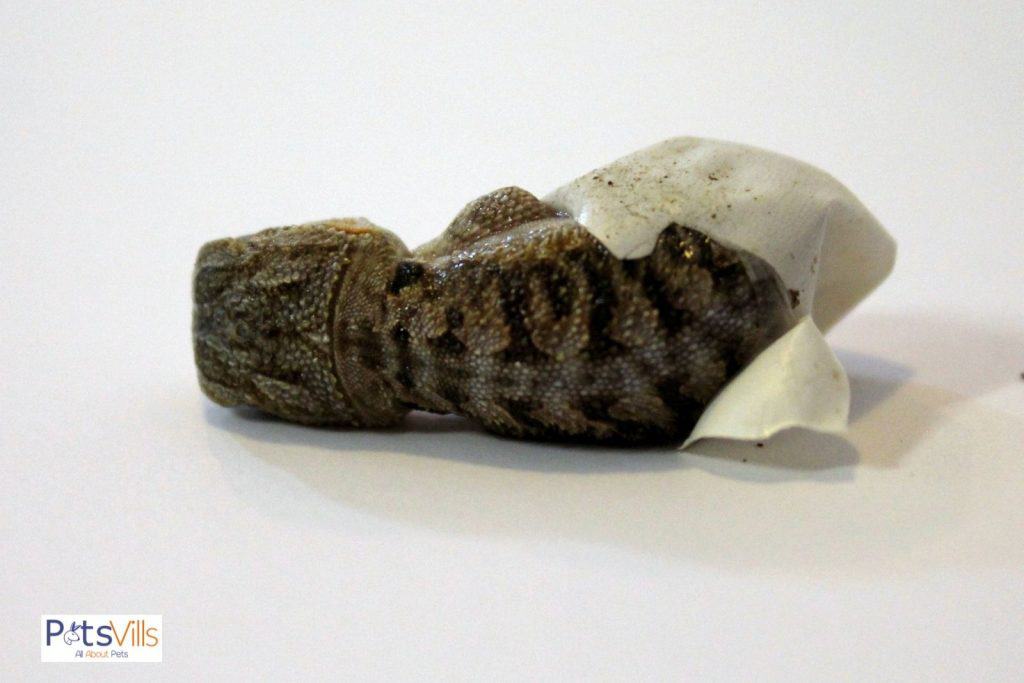
A few days before the baby dragons hatch, dimples and dents appear on the eggs’ surface. Some eggs can also have drops of “moisture” on the surface.
Usually, deflation is a sign of incorrect bearded dragon incubation humidity. But if the levels are within the norm, the eggs are hatching.
The baby reptiles have an egg tooth, which they’ll use to crack the egg. First, you’ll see the snout, and then the head appears from the egg.
Don’t help the baby dragon out of its shell because you can damage the imbecile cord. It can take up to 36 hours for the hatching to hatch, so be patient.
Once the little ones are out of the shell, you should leave them in the bearded dragon incubator for at least a day.
FAQs About Incubating Bearded Dragon Eggs
Do You Need an Incubator to Hatch Bearded Dragon Eggs?
No, you don’t need a bearded lizard incubator. Using a heating lamp and a humidity sensor, you can hatch the eggs in natural soil.
However, it’s easy to maintain consistent temperature and humidity with an incubator, which matters the most for quick hatching.
How Do I Know If My Bearded Dragon Is Gravid?
Gravid females become restless, lose interest in food, and scratch a lot around the vivarium. If you touch your adult bearded lizard’s tummy, you’ll be able to feel the eggs inside – they feel like marbles.
Can Female Bearded Dragons Lay Eggs Without A Male?

Female bearded lizards can lay eggs without mating with a male. However, these eggs are infertile, and no babies will be born, even if you incubate them.
Conclusion
Incubating bearded dragon eggs is easy as long as you keep the humidity and temperature steady. Just remember not to rotate the fragile eggs and handle them with care.
Keep in mind that a female reptile can lay more than 100 eggs per mating season, so you’ll have your hands full of caring for newly hatched bearded lizards.
What do you think about this step-by-step guide on how to hatch bearded dragon eggs? How do you incubate bearded dragon eggs? Share your experience in the comment section.
Resources
- 1. REPRODUCTIVE BIOLOGY OF BEARDED DRAGONS [Internet]. www.lllreptile.com. Available from: https://www.lllreptile.com/articles/154-reproductive-biology-of-bearded-dragons/
- 2. Aubret F, Blanvillain G, Kok PJR. Myth busting? Effects of embryo positioning and egg turning on hatching success in the water snake Natrix maura. Scientific Reports. 2015;5.
- 3. BeardedDragon.org. Bearded Dragon . org | Your ultimate bearded dragon resource @ BeardedDragon.org [Internet]. Beardeddragon.org. 2014. Available from: https://www.beardeddragon.org/
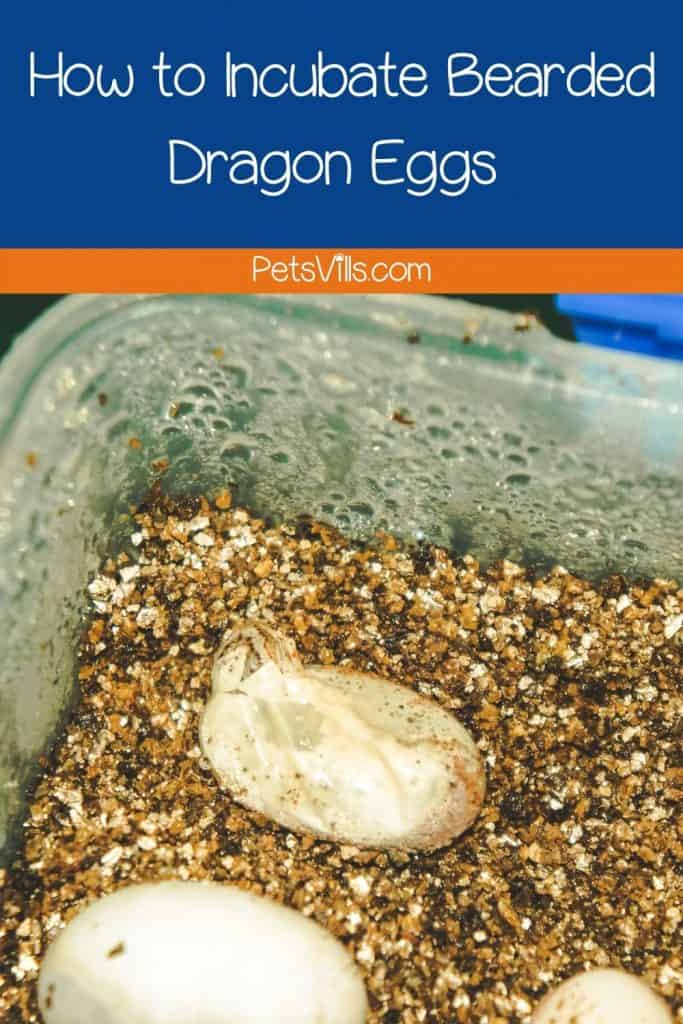
If you have more tips on how to incubate bearded dragon eggs, please let us know in the comments below!
Alina Hartley is a small-town girl with a ginormous love of bearded dragons. It all started with Winchester, a baby bearded who was abandoned at the shelter by his former owners because of a birth defect that caused one front leg to be shorter than the other. Alina originally went to the shelter looking for a guinea pig, but one look at Winchester and it was love at first sight. From that day on, Alina has dedicated her life to learning everything she can about bearded dragons. She loves helping new beardie parents start their incredible journey with these magnificent reptiles.
Follow her on:
LINKEDIN
TWITTER.
Read her latest articles HERE
Learn more about her HERE.

